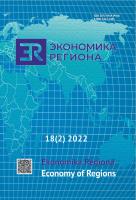Перераспределение первичных доходов населения как фактор снижения неравенства и ускорения экономического роста на региональном уровне
Redistribution of Primary Household Incomes as a Factor for Reducing Inequality and Accelerating Economic Growth at the Regional Level
Author(s): Alexander Shirov, Elena Uzyakova, Marat N. UzyakovSubject(s): Economy, Geography, Regional studies
Published by: Институт экономики Уральского отделения Российской академии наук
Keywords: regional development; economic growth; personal income; income differentiation; income redistribution; income tax
Summary/Abstract: The existing income gaps significantly limit the regional and economic development. At the same time, the high economic growth potential due to the use of consumer demand necessitates the examination of the intensification of this factor of economic dynamics, including through the resource allocation policy. The article considers the macroeconomic efficiency of the redistribution of primary household incomes at the regional level. Regional distribution of the total income of the population by income quintile groups, as well as the average per capita income were analysed based on the data obtained from the Federal State Statistics Service. The redistribution of primary incomes through the differentiation of tax rates is considered the most important factor in increasing the dynamics of consumer demand (an increment of the personal income tax by 12 percentage points (up to 25 %) for the fifth quintile group is used in the calculations). The study aims to assess the possible impact of such redistribution on the income inequality and economic dynamics of Russia and its regions. The potential for gross regional product (GRP) growth resulting from an increase in social support for the least income groups was estimated using the methods of mathematical analysis, multisectoral and interregional modelling. The calculations show that an increase in consumer spending in 2019 in the economy as a whole could have amounted to +5.2 %; the estimate of the increase in total GRP was +2.7 %. Simultaneously, the ratio of the maximum and minimum regional per capita income decreased from 5 to 4 times, while the ratio of per capita GRP (excluding interregional price differentiation) decreased from 61.8 to 56.7 times (maximum/minimum level). The calculation results can be considered the first assessment of the possibilities of overcoming the limitations of regional development caused by low incomes and their significant differentiation. Future detailed studies should focus on developing comprehensive solutions in the field of economic policy.
Journal: Экономика региона
- Issue Year: 18/2022
- Issue No: 2
- Page Range: 423-436
- Page Count: 14
- Language: Russian

